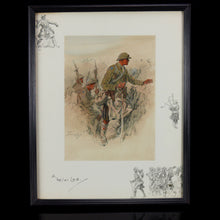Snaffles - ‘Heilan Lad’, 1930
- Regular price
- £875
- Sale price
- £875
- Regular price
-
- Unit price
- /per
Adding product to your cart
Overall: 47cm (18.5in) x 36.5cm (14.2in)
Hand coloured lithograph stamped in the remarque with Snaffles’ trademark blind stamp of two interlocking snaffle bits. Titled after the popular Scottish folk song and regimental march ‘Heilan Laddie’, a kilted officer surveys No Man’s Land in one of Snaffles’ famous series illustrating fighting types of the First World War, upon which his enduring reputation as English sporting and military was established with humorous bye-lines and trade mark vignettes in the border.
Read more

Charlie Johnson Payne (1884-1967), ‘Snaffles’, was the son of a Warwickshire boot maker turned publican. As a boy ‘Snaffles’ was an avid consumer of Kipling and was fascinated by the yarns of a great uncle who had served in the Crimea. After working as a wine merchant’s clerk and joining a volunteer battalion of the Oxfordshire Light Infantry, he enlisted in the Royal Garrison Artillery in 1902 serving as a Gunner until 1905. After lights-out, he used to read Kipling to his mates by candlelight in the barrack room. In the following years he developed his characteristic artistic style and a deepening interest in hunting, racing and polo. He became a regular contributor to periodicals, such as Bystander and the Sporting and Dramatic. Days spent in the hunting field with the Cottesmore provided ample inspiration for his much loved sporting scenes. Following the outbreak of War in 1914, he went to France as an illustrator for The Graphic before entering the Royal Naval Air Service as a rating Motor Mechanic in small coastal motorboats. Later he was commissioned Lieutenant RNVR, and joined the team that developed dazzle camouflage with the Northern Patrol. In 1920 he was made a Chevalier of the Belgian Order of the Crown. His artistic career continued between the wars producing works that often combined military scenes and nostalgic sporting themes. His work covering the equestrian life in England, Ireland and in the military in India was made extremely popular through the publication of prints that were initially hand coloured and later photographically printed over a fifty year period. Apart from the sale of his sporting prints, he contributed to many magazines and publications. During the Second World War he served in the Home Guard, and undertook camouflage work disguising airfields, gasometers and other installations.






